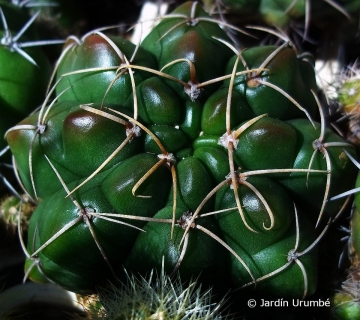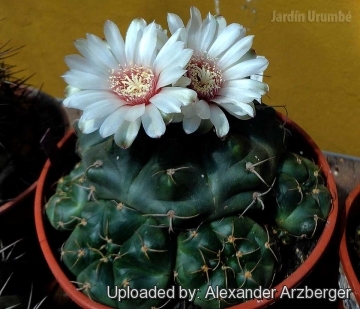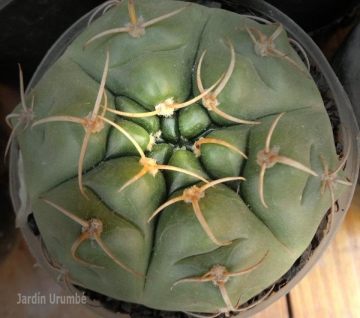Accepted Scientific Name: Gymnocalycium paraguayense (Mundt) Schütz & Moser
Friciana VIII, no. 47: 3- 15 (1972); cf. Rowley in Repert. Pl. Succ. (I. O. S.). 23: 7 (1972 publ. 1974).

Echinocactus paraguayensis (Gymnocalycium paraguayense) Photo by: Alexander Arzberger
Origin and Habitat: Paraguay, departments of Paraguarí and Cordillera, as well as in the region of Chaco
Altitude: 150-300 metres a.s.l.
Habitat: They grows among rocks exposed to full sun or (usually) in semi-shade under small bushes and between grass, or moss, with no presence of other cacti. The climate is subtropical and warm near all the year. During the winter the temperatures could go down until 2º C, but the dark rocks act as an accumulator, keeping the plants at a little higher temperature, forming a special microclimate.
Synonyms:
See all synonyms of Gymnocalycium paraguayense
back
Accepted name in llifle Database:Gymnocalycium paraguayense (Mundt) Schütz & MoserFriciana VIII, no. 47: 3- 15 (1972); cf. Rowley in Repert. Pl. Succ. (I. O. S.). 23: 7 (1972 publ. 1974).Synonymy: 29
Accepted name in llifle Database:Gymnocalycium paraguayense f. fleischerianum (F.Haage) Mereg., D.Metzing & R.KieslingCandollea 57: 313 2002.Synonymy: 14
back
Description: Gymnocalycium paraguayenseSN|18875]]SN|17505]] is an extremly variable species from Paraguay at first solitary slowly forming in age large groups with 20-30 heads. In a single population, you can find all forms of plants with different number, form and length of spines, number and form of ribs etc, and, but for the red throat of the flower, some forms (syn. Gymnocalycium fleischerianumSN|17574]]SN|17574]]) could be confused with Gymnocalycium horstiiSN|17505]]SN|18875]]. However, in its normal form, it cannot be confused.
Stem: Spherical more or less flattened up to 4-5 cm tall and 5-8(-12) cm in diameter, eventually becoming shortly columnar, pale to glossy mid-green tending to bronze in full sun. The more shaded growing plants seem to get bigger with a less tendency to branch.
Ribs: (5-)8-9(-12) or more, straight, angular, divided into more or less noticeable tubercles by well-defined transverse furrows, the tubercles have a protruding chin just below to the areole.
Central spines: Usually absent.
Radial spines: Usually 3 to 9 (mostly 5), unequal, upper spine(s) about 1 cm long, remainder 1-3,5 cm (rarely up to 6 cm) long, outspreading, somewhat curved and adpressed, honey-yellow or pale-brownish at first, fading to white or greyish.
Flowers: Funnel-shaped, dioecious, 4-5(-6) cm long and wide, white with deep pink or wine-red throat (infrequently entirely white). Pericarpel 1-2 cm long, olive green with imbricated scales that are reddish at their tips. Style and stigma are white, stamens pink or whitish and the pollen is yellowish.
Fruit: Almost spherical, pera shaped or shortly club-shaped, up to 1,5 cm long, softening but not splitting when ripe.
Seeds: Large and oval, noticeably broader toward the aril, approx. 1-1,5 mm in diameter, dark brown to black.
Subspecies, varieties, forms and cultivars of plants belonging to the Gymnocalycium paraguayense-fleischerianum group
Accurarated systematics studies based on macromorphology, micromorphology and molecular (RAPD methods), have shown that Gymnocalycium paraguayense (K. Schum.) Hosseus and Gymnocalycium fleischerianum Backeb. (Cactaceae), previously considered as two different species, resulted to be very homogeneous and suggest that all populations should be referred to a single species, composed of two taxa at forma rank. The furrow on the rib between areoles is the main diagnostic character to separate G. paraguayense from G. fleischerianum. However in habitat plants revealed a high intra- and interpopulation level of variability, so that usually only the furrow on the ribs allowed the taxa to be separated; however, in a few single plants even this character is not reliable. Often the plants attributed to G. paraguayense grow in less shallow soil and have a rather flat stem, while those referred to G. fleischerianum are found in shallow soil at the margin of rocky outcrops, where they have a more rounded stem. The general aspect of the plants from each population is usually more or less characteristic.
 Gymnocalycium paraguayense (Mundt) Schütz & Moser: (f. paraguayense) has 8-9 ribs divided into noticeable tubercles and 3 to 9 (mostly 5) radial spines. It is an extremly variable species. Furrow on the rib between areoles present.
Gymnocalycium paraguayense (Mundt) Schütz & Moser: (f. paraguayense) has 8-9 ribs divided into noticeable tubercles and 3 to 9 (mostly 5) radial spines. It is an extremly variable species. Furrow on the rib between areoles present.  Gymnocalycium paraguayense f. fleischerianum (F.Haage) Mereg., D.Metzing & R.Kiesling: It has more spines (up to 9 or more per areole), somewhat curved and close to the often rounder body. Furrow on the rib between areoles absent.
Gymnocalycium paraguayense f. fleischerianum (F.Haage) Mereg., D.Metzing & R.Kiesling: It has more spines (up to 9 or more per areole), somewhat curved and close to the often rounder body. Furrow on the rib between areoles absent.  Gymnocalycium vieditzianum Piltz: It distinguish for the grey-bronzed epidermis and shallow tubercles; It has typically 5 spines.
Gymnocalycium vieditzianum Piltz: It distinguish for the grey-bronzed epidermis and shallow tubercles; It has typically 5 spines.
Bibliography: Major references and further lectures
1) James Cullen, Sabina G. Knees, H. Suzanne Cubey “The European Garden Flora Flowering Plants: A Manual for the Identification of Plants Cultivated in Europe, Both Out-of-Doors and Under Glass” Cambridge University Press, 11/Aug./2011
2) David Hunt, Nigel Taylor “The New Cactus Lexicon” DH Books, 2006 ISBN 0953813444, 9780953813445.
3) Edward F. Anderson “The Cactus Family” Timber Press, 2001
4) Edward F. Anderson : “Das große Kakteen-Lexikon” Eugen Ulmer KG, Stuttgart 2005 (übersetzt von Urs Eggli), ISBN 3-8001-4573-1 , S. 323.
5) Detlev Metzing: “Gymnocalycium paraguayense (K. Schumann) Hosseus” In: Kakteen und andere Sukkulenten . Band 62, Nummer 5, 2011, S. XIXf.
6) Bulletin de l'Herbier Boissier . 2. Folge, Band 3, 1903, S. 252
7) Archivos de la Escuela de Farmacia de la Facultad de Ciencias Medicas de Cordoba . Band 9, 1939, S. 106.
8) Ferd. Haage jun.”Die Varietäten des Echinocactus denudatus Lk. et Otto” In: Monatsschrift für Kakteenkunde . Band 8, Nummer 3, 1898, S. 36–37
 Echinocactus paraguayensis (Gymnocalycium paraguayense) Photo by: Alexander Arzberger
Echinocactus paraguayensis (Gymnocalycium paraguayense) Photo by: Alexander Arzberger Echinocactus paraguayensis (Gymnocalycium paraguayense) Photo by: Alexander Arzberger
Echinocactus paraguayensis (Gymnocalycium paraguayense) Photo by: Alexander Arzberger Echinocactus paraguayensis (Gymnocalycium paraguayense) Photo by: Alexander Arzberger
Echinocactus paraguayensis (Gymnocalycium paraguayense) Photo by: Alexander ArzbergerSend a photo of this plant.The gallery now contains thousands of pictures, however it is possible to do even more. We are, of course, seeking photos of species not yet shown in the gallery but not only that, we are also looking for better pictures than those already present.
Read More... Cultivation and Propagation: Gymnocalycium paraguayenseSN|17505]]SN|17505]] is a summer grower species that is easy to cultivate.
Growth rate: It is a relatively rapidly growing and easily flowering species that will make clumps given the best conditions.
Soils: It likes very porous standard cactus mix soil. pH neutral or acidic, avoid substrata rich in limestone.
Repotting: Use pot with good drainage.
Watering: Needs moderate to copious waterings in summer, but do not overwater (Rot prone), keep dry in winter.
Fertilization: Feed with a high potassium fertilizer in summer.
Hardiness: Reputedly somewhat resistant to frost if kept on the dry side prior to, and during, cold weather (hardy to -5 C ° C, or less for short periods).
Exposition: Outside bright but filtered sunlight or afternoon shade, inside it needs bright light, and some direct sun. Tends to bronze in strong light, which encourages flowering and heavy spine production.
Uses: It is an excellent plant for container growing. It always looks good and stays small. It look fine in a cold greenhouse and frame or outdoor in a rockery.
Pests & diseases: It may be attractive to a variety of insects, but plants in good condition should be nearly pest-free, particularly if they are grown in a mineral potting-mix, with good exposure and ventilation. Nonetheless, there are several pests to watch for:
- Red spiders: Red spiders may be effectively rubbed up by watering the plants from above.
- Mealy bugs: Mealy bugs occasionally develop aerial into the new growth among the wool with disfiguring results, but the worst types develop underground on the roots and are invisible except by their effects.
- Scales: Scales are rarely a problem.
- Rot: Rot it is only a minor problem with cacti if the plants are watered and “aired” correctly. If they are not, fungicides won't help all that much.
Propagation: Division, direct sow after last frost. Seeds germinate in 7-14 days at 21-27° C in spring, remove gradually the glass cover as soon the plants will be well rooted (ca 1-2 weeks) and keep ventilated, no full sun for young plants! To make a cutting twist off a branch and permit it to dry out a couple of weeks, lay it on the soil and insert the stem end partially into the soil. Try to keep the cutting somewhat upright so that the roots are able to grow downward.













